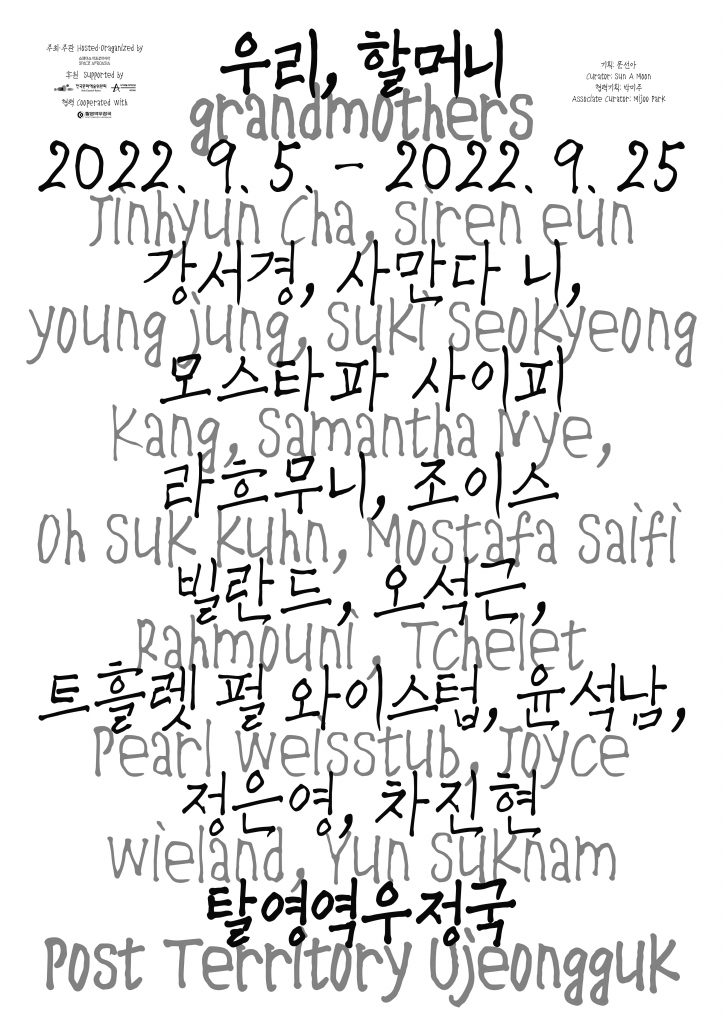
우리, 할머니
2022. 9. 5(월) – 2022. 9. 25(일), 1300:-19:00 휴관일 없읍
오프닝 : 2022년 9월 5일(월) 오후 5시
참여작가 : 강서경, 사만다 니, 모스타파 사이피 라흐무니, 조이스 빌란드, 오석근, 트흘렛 펄 와이스텁, 윤석남, 정은영, 차진현
전시기획 : 문선아
협력기획 : 박미주
주최.주관 : 스페이스 아프로아시아 (http://spaceafroasia.com)
후원 : 한국문화예술위원회·시각예술창작산실
협력 : 탈영역우정국
요즈음의 한국은 바야흐로 ‘혐오의 시대’라고 보아도 무색할 정도로 타인을 대상화하고 일반화하여 엄격한 도덕적 잣대를 들이대는 경향이 있다. 그러나 근거리에서 직접적으로 경험을 하자면, 우리는 모두 ‘인간’과 ‘인간’이라는 ‘함께의 관계’ 속에 있다. 전시 <우리, 할머니>는 남녀노소 구분 없이 함께 공감할 수 있는 할머니들을 전시장으로 초대함으로써 남녀-세대 간의 분리를 뛰어넘어 함께의 관계를 환기하고, 서로에 대한 이해의 자리를 마련코자 한다.
추상적인 의미로서 할머니는 자식들과 손주들을 돌보며 따뜻하고 푸근함을 선사하는, 가정을 위해 헌신한 포용력과 희생의 아이콘으로 존재한다. 한편, 할머니는 제도를 수호하는 완고한 여성상을 상징하기도 한다. 어떤 할머니이든, 그 삶을 들여다보면 격변의 시대를 겪어온 누군가의 딸이었고, 누이거나 언니였고, 엄마였고, 아내였고, 그 스스로였을 아주 단단한 여성들이다. 그 주름살에는 인자함이나 완고함 뿐만 아니라 그 시대의 기록자로서의 세월이 켜켜이 쌓여있는 셈이다. 해서 우리네 할머니의 삶을 돌아보고 할머니와 함께하는 시간을 다시금 마련하는 일은, 과거(현재)를 통해 현재(과거)를 재해석하게 하고 새로운 연대를 마련할 것이다. 전시는 크게 ‘할머니의 일기’, ‘시대의 할머니’, ‘할머니 되기’ 총 세 노드(node)로 구성되고, 이는 견고한 섹션을 구성한다기보다 개념적·공간적으로 서로 교차한다.
grandmothers
Dates : 2022.09.05 (Mon) – 2022.09.25 (Sun), No Holidays during the exhibition
Hours : 1pm – 7pm
Opening Reception : 2022.09.05 (Mon) 5pm
Artists : Jinhyun Cha, siren eun young jung, Suki Seokyeong Kang, Samantha Nye, Oh Suk Kuhn, Mostafa Saifi Rahmouni, Tchelet Pearl Weisstub, Joyce Wieland, Yun Suknam
Curator : Sun A Moon
Associate Curator : Mijoo Park
Hosted and Organized by Space AfroAsia (https://spaceafroasia.com)
Supported by Arts Council Korea
Cooperated with Post Territory Ujeongguk
People these days tend to objectify and generalize others and impose strict moral standards. However, in a close look, we are all in a ‘relationship with each other.’ grandmothers aims to evoke a relationship that transcends diverse gender and age and to create a space for understanding each other by inviting grandmothers.
In an abstract sense, grandmothers exist as icons of tolerance and sacrifice dedicated to their family, providing warmth by caring for their children and grandchildren. On the other hand, the grandmothers also symbolize the stubborn women who protect the system. No matter what kind of grandmother is, she is a very solid woman who must have been someone’s daughter, sister, mother, wife, and herself who has gone through a period of upheaval. In her wrinkles, not only kindness and stubbornness, but also the years are piled up one after another. So, looking back on our grandmothers’ lives and preparing time together will allow us to reinterpret the present (past) through the past (present) and establish a new solidarity. The exhibition is largely composed of three nodes; ‘grandma’s diary’, ‘grandma in the ages’, and ‘becoming grandma’, which intersect conceptually and spatially rather than composing solid sections.
